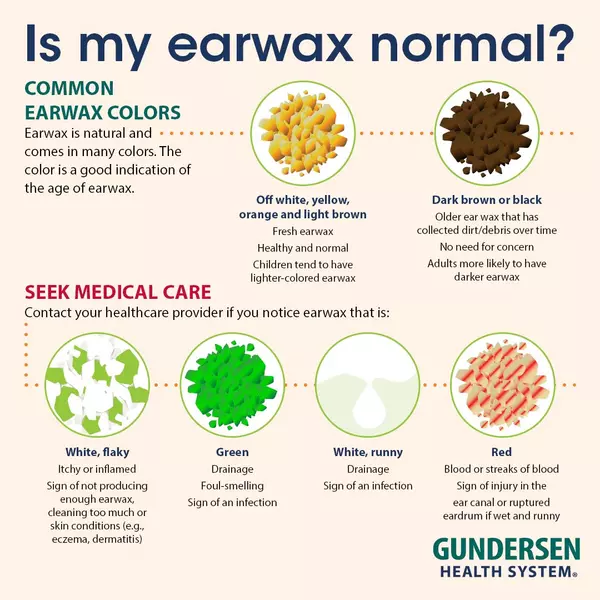
Is my earwax normal?
If you routinely clean your ears with cotton-tipped swabs, listen up.
Many people believe earwax, or cerumen, is a sign of poor hygiene when, in fact, it serves an important purpose in maintaining ear health.
"Earwax traps dirt and dust, acts as a natural moisturizer and protects the inner ear from germs and infection. In fact, people with too little earwax are more likely to experience problems such as itchiness and flaking skin in the ear canal," clarifies Jennifer Guinn, PA-C, Gundersen Otolaryngology.

Ears are self-cleaning
When it comes to proper hygiene, ear experts say the advice is simple: leave your ears alone.
"While the glands in your ears continuously make new earwax, the ears have self-cleaning mechanisms and usually clean themselves. Inserting Q-tips® or other pointed objects into your ears puts you at risk for more problems, including damaging your ear canal or eardrum, or pushing earwax deeper inside causing it to build up and become impacted," states Jennifer.
If you can see earwax in the external ear (outside the hole), it's fine to wipe it with a tissue. However, once you go into the ear canal, Jennifer considers it unsafe. It's best to leave that to a healthcare professional who has the instruments to look inside your ear and remove earwax safely.
Too much earwax?
While earwax is typically more irritating than dangerous, there's a time and a place to seek medical care.
Some people are more prone to producing excess earwax, which can lead to blockages. These patients are typically seen in Otolaryngology every four to six weeks to have their ears cleaned.
In addition, people who wear hearing aids should come in regularly for cleanings, especially during the first six weeks of hearing aid use. "Hearing aids can muzzle load earwax the same way Q-tips do, creating feedback in the device," Jennifer notes.
Safe ways to remove ear wax
No matter how much earwax you produce, Jennifer warns against manual earwax removal or home remedies, such as ear candling which is both unsafe and ineffective.
"The safest way to remove earwax is to have a healthcare provider do so," Jennifer says. "Irrigation—squirting liquid into the ears to soften the earwax—should only be performed if you have no history of ear surgery, ear tubes or perforation of the ear drum. Otherwise, if you have been evaluated by a healthcare provider who deems your ear(s) safe for home washing, then it can be done on a regular basis."
Homemade ear wash solution
Mix 2/3 cup white vinegar with 1/3 cup isopropyl alcohol (also called rubbing alcohol). Keep it in a soft-sided squeeze bottle with a small, rounded tip. (A good choice would be the kind of small squirt bottle that contains saline for contact lens care.) Take the old label off the bottle or write "Ear wash bottle" on it. Gently squirt the mixture in your ear one or more times a day. Use it after you shower or swim. Vinegar helps control germ growth by keeping your inner ear slightly acidic. Rubbing alcohol helps dry your ear. If the solution burns or causes discomfort, you can make it with more rubbing alcohol. Some patients find this works better.
Once your ears are clean, you can use mineral oil weekly or monthly to help soften earwax. This will make it easier to flush out the ear with the mixture described above. Mineral oil can be found in drugstores and grocery stores with other laxatives.
If you aren't successful with ear irrigation after a couple tries, contact your primary care provider or Otolaryngology at (608) 775-2374 to schedule an appointment. This is especially true if notice any of these signs, which could indicate an injury or infection:
- Bleeding from either ear
- Dizziness
- Ringing in your ear
- Sore or aching ear
- Stabbing pain
- Drainage that is colored (white, green, red), thick or foul-smelling
- Decreased hearing
- Itching
- Fever of 101 degrees Fahrenheit or higher
Related articles

Emplify Health by Bellin & Gundersen 2025 Wellness Draft

This new minimally invasive heart procedure is already saving lives

Surviving norovirus and how to recover quickly

How to stay active in the winter